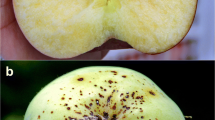Abstract
The effect of temperature on the length of the incubation period of rose powdery mildew, caused by Sphaerotheca pannosa var. rosae, was studied. At constant temperature over the range 8–28°C, the length of the incubation period ranged from 3 to 10 days; no visible colonies developed at 30°C after 19 days. The relationship between temperature and the rate of development of mildew colonies within the incubation period under constant temperature was described by two alternative non-linear models (exponential and thermodynamic). The resulting curves were asymmetrically bell-shaped with an optimum temperature of c. 23°C. The two constant-temperature models predicted the development of powdery mildew under fluctuating temperatures with similar accuracy, even though the exponential model fitted the constant temperature data less well than the thermodynamic model. The thermodynamic model failed to fit the fluctuating-temperature data directly, whereas the exponential model fitted those data directly and the fit was similar to the corresponding model from the constant-temperature data. Fitting the models to the combined (constant and fluctuating temperature) data gave results that were nearly identical to those based on the constant-temperature data alone.
Similar content being viewed by others
References
Beresford RM and Royle DJ (1988) Relationships between leaf emergence and latent period for leaf rust (Puccinia hordei) on spring barley, and their significance for disease monitoring. Journal of Plant Diseases and Protection 95: 361-371
Butt DJ (1978). Epidemiology of powdery mildews. In: Spencer DM (ed) The Powdery Mildews (pp 51-81) Academic Press, London
Eversmeyer MG, Kramer CL and Browder LE (1980) Effect of temperature and host: parasite combination on the latent period of Puccinia recondita in seedling wheat plants. Phytopathology 70: 938-941
Gilligan CA (1990) Comparison of disease progress curves. New Phytologist 115: 223-242
Hau B, Eisensmith SP and Kranz J (1985). Construction of temporal models: II. simulation of aerial epidemics. In: Gilligan CA (ed) Advances in Plant Pathology, Vol. 3: Mathematical Modelling of Crop Disease (pp 31-66) Academic Press, London
Leu LS and Kao CW (1975) Conidial liberation and germination of the rose powdery mildew fungus, Sphaerotheca pannosa. Plant Protection Bulletin, Taiwan 17: 311-318
Longree K (1939) The effect of temperature and relative humidity on powdery mildew of roses. Cornell University Agriculture Experimental Station Memoirs. 223: 1-43
Mence MJ and Hildebrandt AC (1966) Resistance to powdery mildew in rose. Annals of Applied Biology 61: 387-397
Pady SM (1972) Spore release in powdery mildew. Phytopathology 62: 1099-1100
Pathak S and Chorin M (1969) Effects of humidity and temperature conditions on germination of the conidia of Sphaerotheca pannosa (Wallr.) Lev. var rosae Woron. on young and old leaves of three rose varieties.
Payne RW, Lane PW, Todd AD, Digby PGN, Thompson R, Harding SA, T.G. W, Leech PK, Welham SJ, Morgan GW and White RP (1993). Genstat™ 5 relese 3: reference manual. Oxford, Oxford University Press
Perera RG (1972). Studies of conidial germination in some powdery mildew fungi. Ph.D thesis, University of London, London
Price TV (1970) Epidemiology and control of powdery mildew (Sphaerotheca pannosa) on roses. Annals of Applied Biology 65: 231-248
Rogers GS (1959) Some effects of moisture and host plant susceptibility on the development of powdery mildew of roses, caused by Sphaerotheca pannosa var. rosae. Memoir, Cornell University Agriculture Experimental Station 363: 1-37
Shaw MW (1990) Effects of temperature, leaf wetness and cultivar on the latent period of Mycosphaerella graminicola on winter wheat. Plant Pathology 39: 255-268
Sivapalan A (1993a) Effects of impacting rain drops on the growth and development of powdery mildew fungi. Plant Pathology 42: 256-263
Sivapalan A (1993b) Effects of water on germination of powdery mildew conidia. Mycol. Res. 97: 71-76
Tammen JF (1973) Rose powdery mildew studied for epidemics. Science in Agriculture 20: 10
Wadia KDR and Butler DR (1994) Relationship between temperature and latent periods of rust and leaf-spot diseases of groundnut. Plant Pathology 43: 121-129
Wagner TL, Wu HI, Sharpe PJH, Schoolfield RM and Coulson RN (1984) Modelling insect development rates: a literature review and application of a biophysical model. Annals of the Entomological Society of America 77: 208-225
Wheeler BEJ (1978) Powdery mildews of ornamentals. In: Spencer DM (ed) The Powdery Mildews (pp 411-441) Academic Press, London
Xu X-M (1996a) The effects of constant and fluctuating temperatures on the length of the incubation period of apple powdery mildew (Podosphaera leucotricha). Plant Pathology 45: 924-932
Xu X-M (1996b) On estimating non-linear response of fungal development under fluctuating temperatures. Plant Pathology 45: 163-171
Xu X-M and Butt DJ (1998) Effects of temperature and atmospheric moisture on the early growth of apple powdery mildew (Podosphaera leutricha) colonies. European Journal of Plant Pathology 104: 133-140
Author information
Authors and Affiliations
Rights and permissions
About this article
Cite this article
Xu, XM. Effects of Temperature on the Length of the Incubation Period of Rose Powdery Mildew (Sphaerotheca pannosa var. rosae). European Journal of Plant Pathology 105, 13–21 (1999). https://doi.org/10.1023/A:1008666605593
Issue Date:
DOI: https://doi.org/10.1023/A:1008666605593




